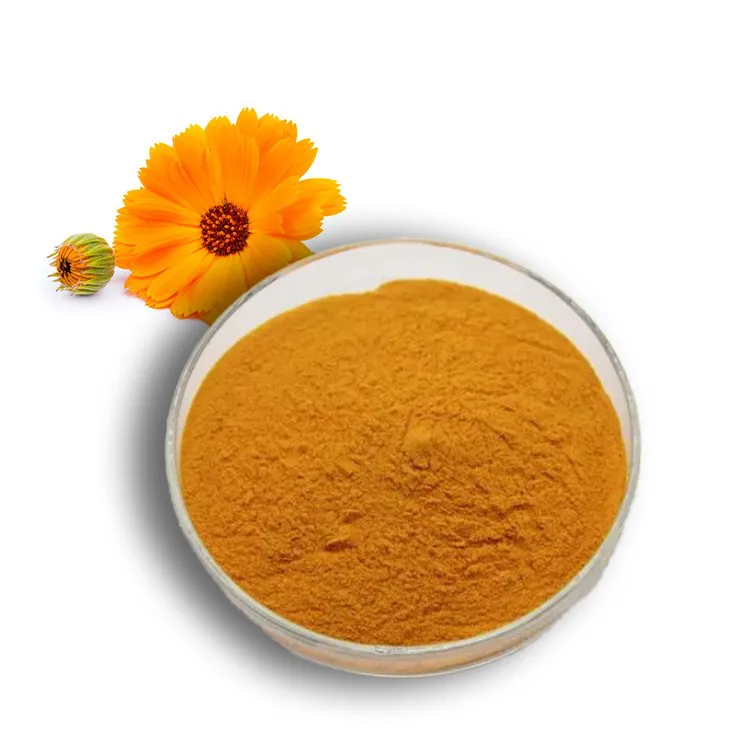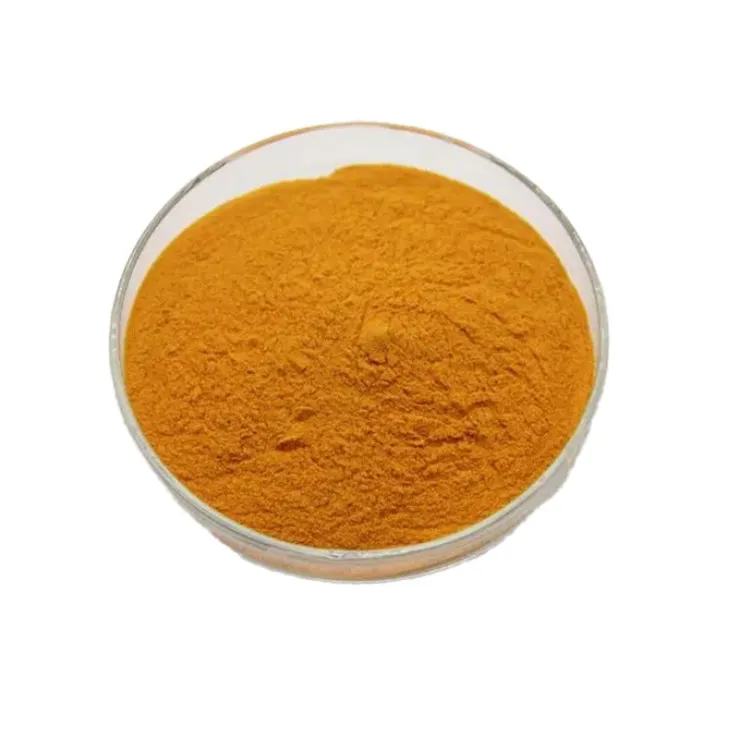- 0086-571-85302990
- sales@greenskybio.com
How to make powder with calendula extract.
2024-11-28

1. Introduction to Calendula
Calendula, also known as pot marigold, is a plant with a long history of use in various applications, especially in herbal medicine and cosmetics. It is rich in flavonoids, triterpenoids, and other bioactive compounds, which are responsible for its antioxidant, anti - inflammatory, and antimicrobial properties. These properties make Calendula Extract a valuable ingredient for a wide range of products, and converting it into powder form can further enhance its usability and shelf - life.

2. Sourcing Calendula
2.1. Growing Calendula
- Calendula is a relatively easy plant to grow. It prefers well - drained soil and full sun. You can start the seeds indoors in early spring and transplant them outside after the last frost.
- When growing calendula, it is important to ensure that it is not exposed to excessive moisture, as this can lead to fungal diseases. Regular watering, but not over - watering, is the key to healthy calendula plants.
- Calendula can also be grown in pots, which is a great option for those with limited garden space or who want to have more control over the growing conditions.
2.2. Purchasing Calendula
- If you do not have the resources or space to grow calendula, you can purchase it from various sources. Look for dried calendula flowers in herbal stores, health food stores, or online retailers.
- When purchasing calendula, make sure to choose high - quality products. Check for the origin of the product, the harvesting methods, and the presence of any additives or preservatives.
- It is also advisable to purchase organic calendula if possible, as it is less likely to be contaminated with pesticides or other chemicals.

3. Extracting Calendula
3.1. Solvent Extraction
- One of the most common methods of extracting calendula is solvent extraction. For this, you will need a suitable solvent such as ethanol or olive oil.
- Take a quantity of dried calendula flowers and place them in a glass container. Add the solvent in a ratio of about 1:5 (calendula:solvent). For example, if you have 100 grams of calendula, add 500 milliliters of solvent.
- Seal the container tightly and let it sit for at least 2 - 3 weeks. During this time, the solvent will extract the active compounds from the calendula. Shake the container gently every few days to ensure proper extraction.
- After the extraction period, strain the mixture through a cheesecloth or a fine - mesh sieve to separate the liquid extract from the solid plant material.
3.2. Water - based Extraction
- Water - based extraction is another option for obtaining Calendula Extract. Boil a quantity of dried calendula flowers in water for about 15 - 20 minutes.
- Use a ratio of about 1:10 (calendula:water). For example, 50 grams of calendula to 500 milliliters of water.
- After boiling, let the mixture cool down and then strain it through a sieve or cheesecloth. The resulting liquid is the water - based Calendula Extract.
- However, water - based extracts may have a shorter shelf - life compared to solvent - based extracts, as they are more prone to microbial growth.

4. Drying the Extract
4.1. Air Drying
- Once you have obtained the calendula extract, the next step is to dry it to make powder. Air drying is a simple and natural method. Pour the extract onto a clean, flat surface such as a baking sheet lined with parchment paper.
- Place the baking sheet in a well - ventilated area away from direct sunlight. The extract will gradually dry as the water or solvent evaporates. This process can take several days to a week, depending on the humidity and the amount of extract.
- During air drying, it is important to stir the extract occasionally to ensure even drying. Also, protect the drying extract from dust and other contaminants.
4.2. Using a Dehydrator
- If you want a faster drying process, you can use a food dehydrator. Set the dehydrator to a low temperature, usually around 40 - 50°C (104 - 122°F).
- Pour the extract into the dehydrator trays, making sure it is spread evenly. The dehydrator will blow warm air over the extract, speeding up the drying process.
- Depending on the thickness of the extract layer and the power of the dehydrator, the drying process can be completed in a few hours to a day.
4.3. Freeze Drying
- Freeze drying is a more advanced and expensive method but can result in a high - quality powder. In this process, the extract is first frozen and then placed in a freeze - dryer.
- The freeze - dryer removes the water or solvent by sublimation, which is the transition from a solid (ice) directly to a gas without passing through the liquid phase.
- This method preserves the bioactive compounds in the extract very well and results in a fine, easily soluble powder. However, freeze - drying equipment is not commonly available in home kitchens and is more suitable for commercial or laboratory settings.

5. Grinding the Dried Extract into Powder
5.1. Using a Mortar and Pestle
- Once the extract is completely dried, it can be ground into powder. A mortar and pestle is a traditional and simple tool for this purpose. Place the dried extract in the mortar.
- Use the pestle to grind the extract into a fine powder. This may take some time and effort, especially if the extract is tough or sticky. You can add a small amount of a dry, inert substance such as rice flour or cornstarch to help with the grinding process if needed.
- Continue grinding until you obtain a powder with a consistent texture.
5.2. Using a Blender or Food Processor
- If you have a blender or food processor, these can also be used to grind the dried extract into powder. Place the dried extract in the blender or food processor container.
- Run the blender or food processor on a low speed at first, gradually increasing the speed if necessary. Stop and check the consistency of the powder frequently, as over - grinding can cause the powder to become too fine and potentially lose some of its properties.
- If the extract does not grind evenly, you can break it into smaller pieces and try again.
6. Tips for Optimal Powder Production
6.1. Quality Control of Raw Materials
- As mentioned earlier, the quality of the calendula used for extraction is crucial. Always ensure that the calendula is fresh, clean, and free from contaminants.
- If growing your own calendula, follow good agricultural practices. If purchasing, choose reliable suppliers.
- Check the solvent or water used for extraction as well. High - quality solvents or clean water will result in a better - quality extract and ultimately a better - quality powder.
6.2. Controlling the Drying Process
- Proper drying is essential for obtaining a good - quality powder. Avoid over - drying or under - drying the extract.
- If air drying, monitor the humidity and temperature of the drying area. If using a dehydrator or freeze - dryer, follow the manufacturer's instructions carefully.
- Any moisture left in the dried extract can cause clumping when grinding into powder or can lead to spoilage during storage.
6.3. Storage of the Powder
- Once the calendula extract powder is produced, it should be stored properly to maintain its quality. Store the powder in an airtight container in a cool, dry place.
- Avoid exposure to sunlight and moisture, as these can degrade the bioactive compounds in the powder over time.
- Label the container with the date of production and the contents for easy identification and tracking.
7. Conclusion
Making powder from calendula extract involves several steps, from sourcing the calendula to the final grinding of the dried extract. By following the methods and tips described in this article, you can produce high - quality calendula extract powder. This powder can be used in a variety of applications, such as in herbal medicine, cosmetics, and food supplements. The versatility and beneficial properties of calendula make it a valuable ingredient, and having it in powder form offers convenience and ease of use in different formulations.
FAQ:
What is the best source of calendula for extract?
Calendula officinalis is the most commonly used species for extraction. It should be fresh and of high quality. Ideally, it is organically grown to avoid any chemical residues. The petals are the main part used as they contain a high concentration of the active compounds.
What are the typical extraction methods for calendula?
One common method is maceration. In this process, calendula petals are soaked in a suitable solvent such as ethanol or oil for a period of time. Another method is steam distillation, which is mainly used for extracting the essential oils from calendula. For making an extract for powder production, solvent extraction like using ethanol is often preferred as it can extract a wide range of active compounds.
How to dry calendula extract properly?
Low - temperature drying is recommended. You can use a vacuum dryer or a dehydrator set at a low temperature. This helps to preserve the active compounds in the extract. Air - drying can also be done in a clean and dry environment, but it may take longer and there is a risk of contamination.
What are the factors affecting the quality of calendula extract powder?
The quality of the starting material (calendula), the extraction method, the drying process, and storage conditions all affect the quality of the powder. If the calendula is of poor quality, the extract and resulting powder will also be sub - optimal. Improper extraction may not fully extract the active compounds. Incorrect drying can lead to degradation of the compounds, and improper storage can cause spoilage or loss of potency.
Are there any safety precautions during the production of calendula extract powder?
When using solvents like ethanol for extraction, proper ventilation is necessary as ethanol is flammable. Gloves and protective eyewear should be worn. Also, ensure that the drying equipment is used according to the manufacturer's instructions to avoid any safety hazards. Additionally, make sure the calendula is free from pesticides or other contaminants before starting the extraction process.
Related literature
- Calendula: Properties, Applications, and Extraction Techniques"
- "Optimizing the Production of Calendula Extract Powder: A Comprehensive Guide"
- "The Science behind Calendula Extraction and Powder Formation"
- ▶ Hesperidin
- ▶ citrus bioflavonoids
- ▶ plant extract
- ▶ lycopene
- ▶ Diosmin
- ▶ Grape seed extract
- ▶ Sea buckthorn Juice Powder
- ▶ Beetroot powder
- ▶ Hops Extract
- ▶ Artichoke Extract
- ▶ Reishi mushroom extract
- ▶ Astaxanthin
- ▶ Green Tea Extract
- ▶ Curcumin Extract
- ▶ Horse Chestnut Extract
- ▶ Other Problems
- ▶ Boswellia Serrata Extract
- ▶ Resveratrol Extract
- ▶ Marigold Extract
- ▶ Grape Leaf Extract
- ▶ blog3
- ▶ blog4
-
The best - quality feverfew extract.
2024-11-28
-
The best organic aged garlic extract.
2024-11-28
-
Konjac flour manufacturers from China.
2024-11-28
-
Certified organic comfrey extract.
2024-11-28
-
The best sophora japonica extract in 2024.
2024-11-28
-
Black Rice Extract Manufacturers from China.
2024-11-28
-
Nature's Bounty Rhodiola Root Extract.
2024-11-28
-
Peppermint oil manufacturers from China.
2024-11-28
-
Sugarcane Extract
2024-11-28
-
Curcuma Longa Extract/Turmeric extract
2024-11-28
-
Tamarind extract powder
2024-11-28
-
Echinacea Extract
2024-11-28
-
Hops Extract
2024-11-28
-
Berberis aristata Extract
2024-11-28
-
Plantain extract
2024-11-28
-
Sea buckthorn Juice Powder
2024-11-28
-
Artichoke Extract
2024-11-28
-
Elderberry Extract
2024-11-28





















